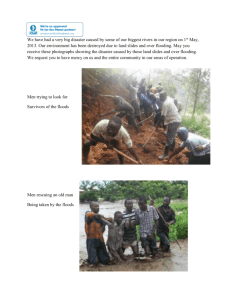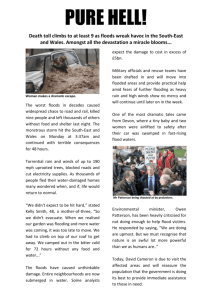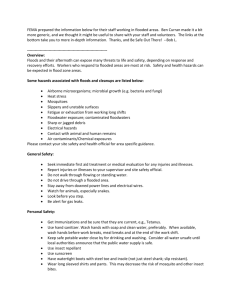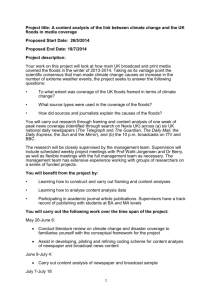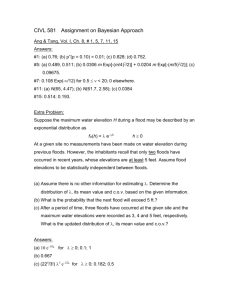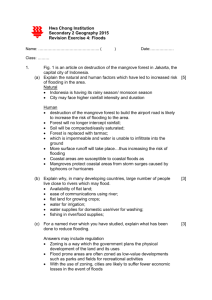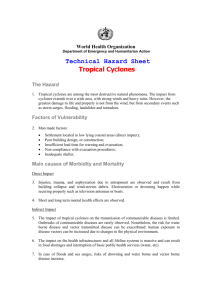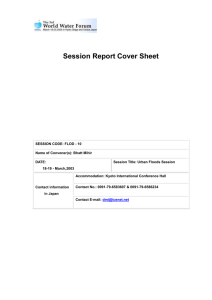Direct impact - World Health Organization
advertisement
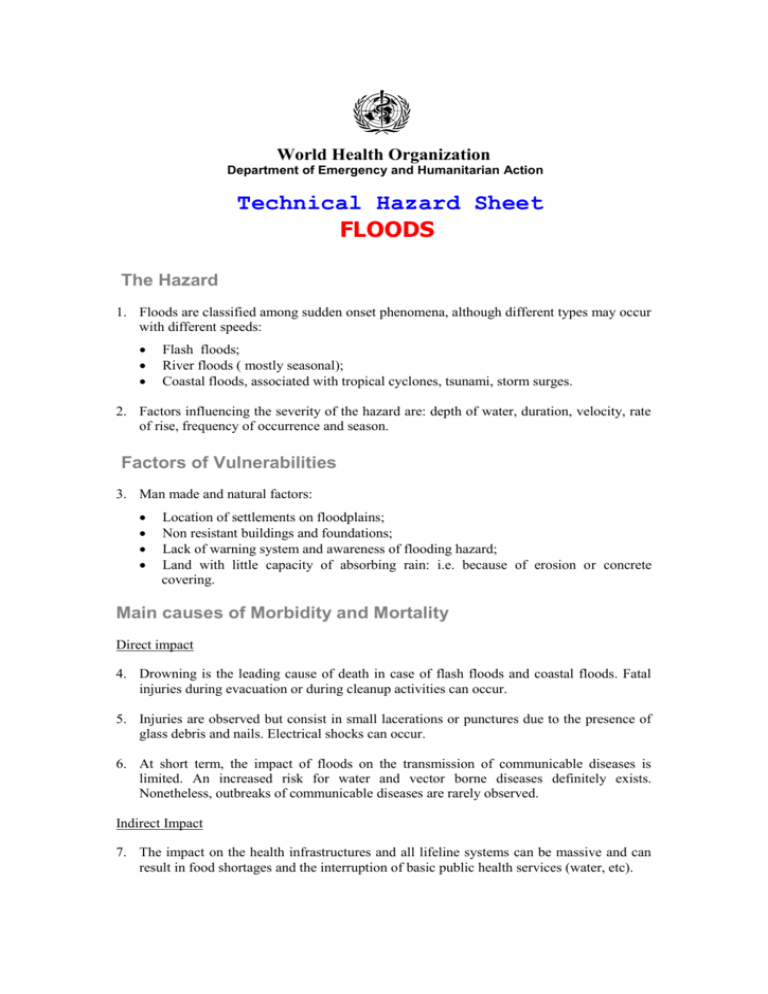
World Health Organization Department of Emergency and Humanitarian Action Technical Hazard Sheet FLOODS The Hazard 1. Floods are classified among sudden onset phenomena, although different types may occur with different speeds: Flash floods; River floods ( mostly seasonal); Coastal floods, associated with tropical cyclones, tsunami, storm surges. 2. Factors influencing the severity of the hazard are: depth of water, duration, velocity, rate of rise, frequency of occurrence and season. Factors of Vulnerabilities 3. Man made and natural factors: Location of settlements on floodplains; Non resistant buildings and foundations; Lack of warning system and awareness of flooding hazard; Land with little capacity of absorbing rain: i.e. because of erosion or concrete covering. Main causes of Morbidity and Mortality Direct impact 4. Drowning is the leading cause of death in case of flash floods and coastal floods. Fatal injuries during evacuation or during cleanup activities can occur. 5. Injuries are observed but consist in small lacerations or punctures due to the presence of glass debris and nails. Electrical shocks can occur. 6. At short term, the impact of floods on the transmission of communicable diseases is limited. An increased risk for water and vector borne diseases definitely exists. Nonetheless, outbreaks of communicable diseases are rarely observed. Indirect Impact 7. The impact on the health infrastructures and all lifeline systems can be massive and can result in food shortages and the interruption of basic public health services (water, etc). 8. Contamination by toxic chemicals during floods is theoretically possible but no verifiable correlation has been observed or measured so far. Foreseeable needs 9. Pending an accurate assessment, needs can be anticipated such as: search and rescue, medical assistance, evacuating and managing population displacement and reducing the individual risk of being exposed to water-borne and vector-borne diseases in the short term, raising awareness on the risk associated with cleanup activities, and maintaining food security conditions over the long term (crops and livestock are likely to be lost). Don't Forget 10. Warning is possible well in advance for seasonal floods, but only minutes before in case of flash floods or most coastal floods. 11. Specific mitigation measures range from flood detection, warning systems, public education, to large-scale floodplains management. Inappropriate Response 12. Do not send vaccines and do not engage in mass immunisation campaigns before consulting with WHO. 13. Used clothing, shoes: do not send! In most cases, the local community donates more than enough of these items to meet the demand. It is more economical, convenient and sanitary to purchase items locally than to ship used items. 14. Temporary shelter such as tents, do not send them! Temporary resettlements in relative houses or in public edifices are by far more appropriate than creating population displacement camps. Prepared by: Department of Emergency and Humanitarian Action Emergency Health Intelligence and Capacity Building. WHO/Geneva. Please contact: eha@who.ch for further information Contacts for specific, related topics For further information on: Please contact: Environmental Emergencies Mr J Hueb +(41 22) 791 3553 or Huebj@who.int Mr O Adams +(41 22) 791 2889 or Adamso@who.int Dr E Krug +(41 22) 791 3535 or Kruge@who.int Dr M Connolly +(41 22) 791 4142 or connollyma@who.int Organization of Health Service Delivery Injuries and Violence Prevention Communicable Diseases Control, Prevention and Eradication For further reading: An Overview of Disaster Management, 2nd ed. Geneva, United Nations Development Programme, Disaster Management Training Programme, 1992. Assessing the Needs in the Health Sector after Floods and Hurricanes. Washington, Pan American Health Organization Technical Publication 11, 1987. Coping with Natural Disasters: The Role of Local Health Personnel and the Community. Geneva, World Health Organization, 1989. Do’s and Don’ts After Natural Disasters. Washington, Pan American Health Organization Press Release, 1998. Emergency Health Management after Natural Disaster. Washington, Pan American Health Organization Scientific Publication 407, 1981. Natural Disasters: Protecting the Public’s Health. Washington, Pan American Health Organization Scientific Publication 575, 2000. Noji E. Public Health Consequences of Disasters. New York, Oxford University Press, 1997.Noji E. Public Health Consequences of Disasters. New York, Oxford University Press, 1997. La Fundacion Nacional de Salud de Brasil (FUNASA) http://www.funasa.gov.br/epi/enchentes/enchentes00.htm

